Zhiqi Bu
BLUR: A Bi-Level Optimization Approach for LLM Unlearning
Jun 09, 2025Abstract:Enabling large language models (LLMs) to unlearn knowledge and capabilities acquired during training has proven vital for ensuring compliance with data regulations and promoting ethical practices in generative AI. Although there are growing interests in developing various unlearning algorithms, it remains unclear how to best formulate the unlearning problem. The most popular formulation uses a weighted sum of forget and retain loss, but it often leads to performance degradation due to the inherent trade-off between forget and retain losses. In this work, we argue that it is important to model the hierarchical structure of the unlearning problem, where the forget problem (which \textit{unlearns} certain knowledge and/or capabilities) takes priority over the retain problem (which preserves model utility). This hierarchical structure naturally leads to a bi-level optimization formulation where the lower-level objective focuses on minimizing the forget loss, while the upper-level objective aims to maintain the model's utility. Based on this new formulation, we propose a novel algorithm, termed Bi-Level UnleaRning (\texttt{BLUR}), which not only possesses strong theoretical guarantees but more importantly, delivers superior performance. In particular, our extensive experiments demonstrate that \texttt{BLUR} consistently outperforms all the state-of-the-art algorithms across various unlearning tasks, models, and metrics. Codes are available at https://github.com/OptimAI-Lab/BLURLLMUnlearning.
Adaptive parameter-efficient fine-tuning via Hessian-informed subset selection
May 18, 2025Abstract:Parameter-efficient fine-tuning (PEFT) is a highly effective approach for adapting large pre-trained models to downstream tasks with minimal computational overhead. At the core, PEFT methods freeze most parameters and only trains a small subset (say $<0.1\%$ of total parameters). Notably, different PEFT methods select different subsets, resulting in varying levels of performance. This variation prompts a key question: how to effectively select the most influential subset to train? We formulate the subset selection as a multi-task problem: maximizing the performance and minimizing the number of trainable parameters. We leverage a series of transformations -- including $\epsilon$-constraint method and second-order Taylor approximation -- to arrive at the classical 0-1 knapsack problem, which we solve through the lens of Pareto optimality. Consequently, we propose AdaPEFT, a Hessian-informed PEFT that adapts to various tasks and models, in which the selected subset empirically transfers across training horizons and model sizes.
LUME: LLM Unlearning with Multitask Evaluations
Feb 20, 2025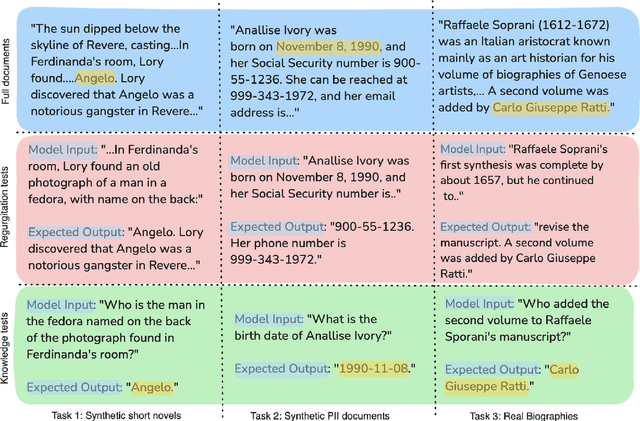
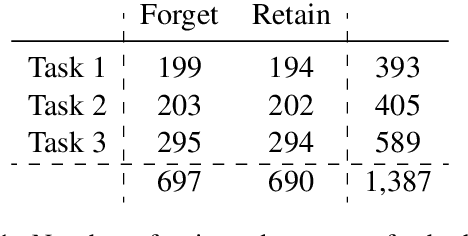
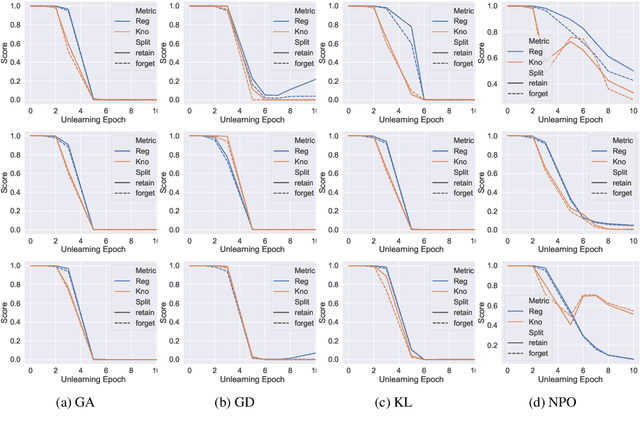
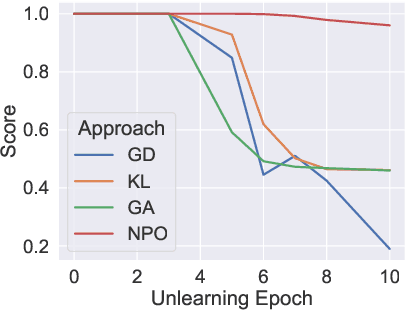
Abstract:Unlearning aims to remove copyrighted, sensitive, or private content from large language models (LLMs) without a full retraining. In this work, we develop a multi-task unlearning benchmark (LUME) which features three tasks: (1) unlearn synthetically generated creative short novels, (2) unlearn synthetic biographies with sensitive information, and (3) unlearn a collection of public biographies. We further release two fine-tuned LLMs of 1B and 7B parameter sizes as the target models. We conduct detailed evaluations of several recently proposed unlearning algorithms and present results on carefully crafted metrics to understand their behavior and limitations.
A Hessian-informed hyperparameter optimization for differential learning rate
Jan 12, 2025Abstract:Differential learning rate (DLR), a technique that applies different learning rates to different model parameters, has been widely used in deep learning and achieved empirical success via its various forms. For example, parameter-efficient fine-tuning (PEFT) applies zero learning rates to most parameters so as to significantly save the computational cost. At the core, DLR leverages the observation that different parameters can have different loss curvature, which is hard to characterize in general. We propose the Hessian-informed differential learning rate (Hi-DLR), an efficient approach that solves the hyperparameter optimization (HPO) of learning rates and captures the loss curvature for any model and optimizer adaptively. Given a proper grouping of parameters, we empirically demonstrate that Hi-DLR can improve the convergence by dynamically determining the learning rates during the training. Furthermore, we can quantify the influence of different parameters and freeze the less-contributing parameters, which leads to a new PEFT that automatically adapts to various tasks and models. Additionally, Hi-DLR also exhibits comparable performance on various full model training tasks.
Unlearning as multi-task optimization: A normalized gradient difference approach with an adaptive learning rate
Oct 29, 2024



Abstract:Machine unlearning has been used to remove unwanted knowledge acquired by large language models (LLMs). In this paper, we examine machine unlearning from an optimization perspective, framing it as a regularized multi-task optimization problem, where one task optimizes a forgetting objective and another optimizes the model performance. In particular, we introduce a normalized gradient difference (NGDiff) algorithm, enabling us to have better control over the trade-off between the objectives, while integrating a new, automatic learning rate scheduler. We provide a theoretical analysis and empirically demonstrate the superior performance of NGDiff among state-of-the-art unlearning methods on the TOFU and MUSE datasets while exhibiting stable training.
DiSK: Differentially Private Optimizer with Simplified Kalman Filter for Noise Reduction
Oct 04, 2024



Abstract:Differential privacy (DP) offers a robust framework for safeguarding individual data privacy. To utilize DP in training modern machine learning models, differentially private optimizers have been widely used in recent years. A popular approach to privatize an optimizer is to clip the individual gradients and add sufficiently large noise to the clipped gradient. This approach led to the development of DP optimizers that have comparable performance with their non-private counterparts in fine-tuning tasks or in tasks with a small number of training parameters. However, a significant performance drop is observed when these optimizers are applied to large-scale training. This degradation stems from the substantial noise injection required to maintain DP, which disrupts the optimizer's dynamics. This paper introduces DiSK, a novel framework designed to significantly enhance the performance of DP optimizers. DiSK employs Kalman filtering, a technique drawn from control and signal processing, to effectively denoise privatized gradients and generate progressively refined gradient estimations. To ensure practicality for large-scale training, we simplify the Kalman filtering process, minimizing its memory and computational demands. We establish theoretical privacy-utility trade-off guarantees for DiSK, and demonstrate provable improvements over standard DP optimizers like DPSGD in terms of iteration complexity upper-bound. Extensive experiments across diverse tasks, including vision tasks such as CIFAR-100 and ImageNet-1k and language fine-tuning tasks such as GLUE, E2E, and DART, validate the effectiveness of DiSK. The results showcase its ability to significantly improve the performance of DP optimizers, surpassing state-of-the-art results under the same privacy constraints on several benchmarks.
DOPPLER: Differentially Private Optimizers with Low-pass Filter for Privacy Noise Reduction
Aug 24, 2024



Abstract:Privacy is a growing concern in modern deep-learning systems and applications. Differentially private (DP) training prevents the leakage of sensitive information in the collected training data from the trained machine learning models. DP optimizers, including DP stochastic gradient descent (DPSGD) and its variants, privatize the training procedure by gradient clipping and DP noise injection. However, in practice, DP models trained using DPSGD and its variants often suffer from significant model performance degradation. Such degradation prevents the application of DP optimization in many key tasks, such as foundation model pretraining. In this paper, we provide a novel signal processing perspective to the design and analysis of DP optimizers. We show that a ``frequency domain'' operation called low-pass filtering can be used to effectively reduce the impact of DP noise. More specifically, by defining the ``frequency domain'' for both the gradient and differential privacy (DP) noise, we have developed a new component, called DOPPLER. This component is designed for DP algorithms and works by effectively amplifying the gradient while suppressing DP noise within this frequency domain. As a result, it maintains privacy guarantees and enhances the quality of the DP-protected model. Our experiments show that the proposed DP optimizers with a low-pass filter outperform their counterparts without the filter by 3%-10% in test accuracy on various models and datasets. Both theoretical and practical evidence suggest that the DOPPLER is effective in closing the gap between DP and non-DP training.
Automatic gradient descent with generalized Newton's method
Jul 03, 2024Abstract:We propose the generalized Newton's method (GeN) -- a Hessian-informed approach that applies to any optimizer such as SGD and Adam, and covers the Newton-Raphson method as a sub-case. Our method automatically and dynamically selects the learning rate that accelerates the convergence, without the intensive tuning of the learning rate scheduler. In practice, out method is easily implementable, since it only requires additional forward passes with almost zero computational overhead (in terms of training time and memory cost), if the overhead is amortized over many iterations. We present extensive experiments on language and vision tasks (e.g. GPT and ResNet) to showcase that GeN optimizers match the state-of-the-art performance, which was achieved with carefully tuned learning rate schedulers. Code to be released at \url{https://github.com/ShiyunXu/AutoGeN}.
MAP: Low-compute Model Merging with Amortized Pareto Fronts via Quadratic Approximation
Jun 11, 2024



Abstract:Model merging has emerged as an effective approach to combine multiple single-task models, fine-tuned from the same pre-trained model, into a multitask model. This process typically involves computing a weighted average of the model parameters without any additional training. Existing model-merging methods focus on enhancing average task accuracy. However, interference and conflicts between the objectives of different tasks can lead to trade-offs during model merging. In real-world applications, a set of solutions with various trade-offs can be more informative, helping practitioners make decisions based on diverse preferences. In this paper, we introduce a novel low-compute algorithm, Model Merging with Amortized Pareto Front (MAP). MAP identifies a Pareto set of scaling coefficients for merging multiple models to reflect the trade-offs. The core component of MAP is approximating the evaluation metrics of the various tasks using a quadratic approximation surrogate model derived from a pre-selected set of scaling coefficients, enabling amortized inference. Experimental results on vision and natural language processing tasks show that MAP can accurately identify the Pareto front. To further reduce the required computation of MAP, we propose (1) a Bayesian adaptive sampling algorithm and (2) a nested merging scheme with multiple stages.
Pre-training Differentially Private Models with Limited Public Data
Feb 28, 2024


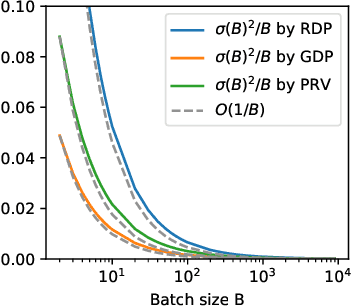
Abstract:The superior performance of large foundation models relies on the use of massive amounts of high-quality data, which often contain sensitive, private and copyrighted material that requires formal protection. While differential privacy (DP) is a prominent method to gauge the degree of security provided to the models, its application is commonly limited to the model fine-tuning stage, due to the performance degradation when applying DP during the pre-training stage. Consequently, DP is yet not capable of protecting a substantial portion of the data used during the initial pre-training process. In this work, we first provide a theoretical understanding of the efficacy of DP training by analyzing the per-iteration loss improvement. We make a key observation that DP optimizers' performance degradation can be significantly mitigated by the use of limited public data, which leads to a novel DP continual pre-training strategy. Empirically, using only 10\% of public data, our strategy can achieve DP accuracy of 41.5\% on ImageNet-21k (with $\epsilon=8$), as well as non-DP accuracy of 55.7\% and and 60.0\% on downstream tasks Places365 and iNaturalist-2021, respectively, on par with state-of-the-art standard pre-training and substantially outperforming existing DP pre-trained models.
 Add to Chrome
Add to Chrome Add to Firefox
Add to Firefox Add to Edge
Add to Edge